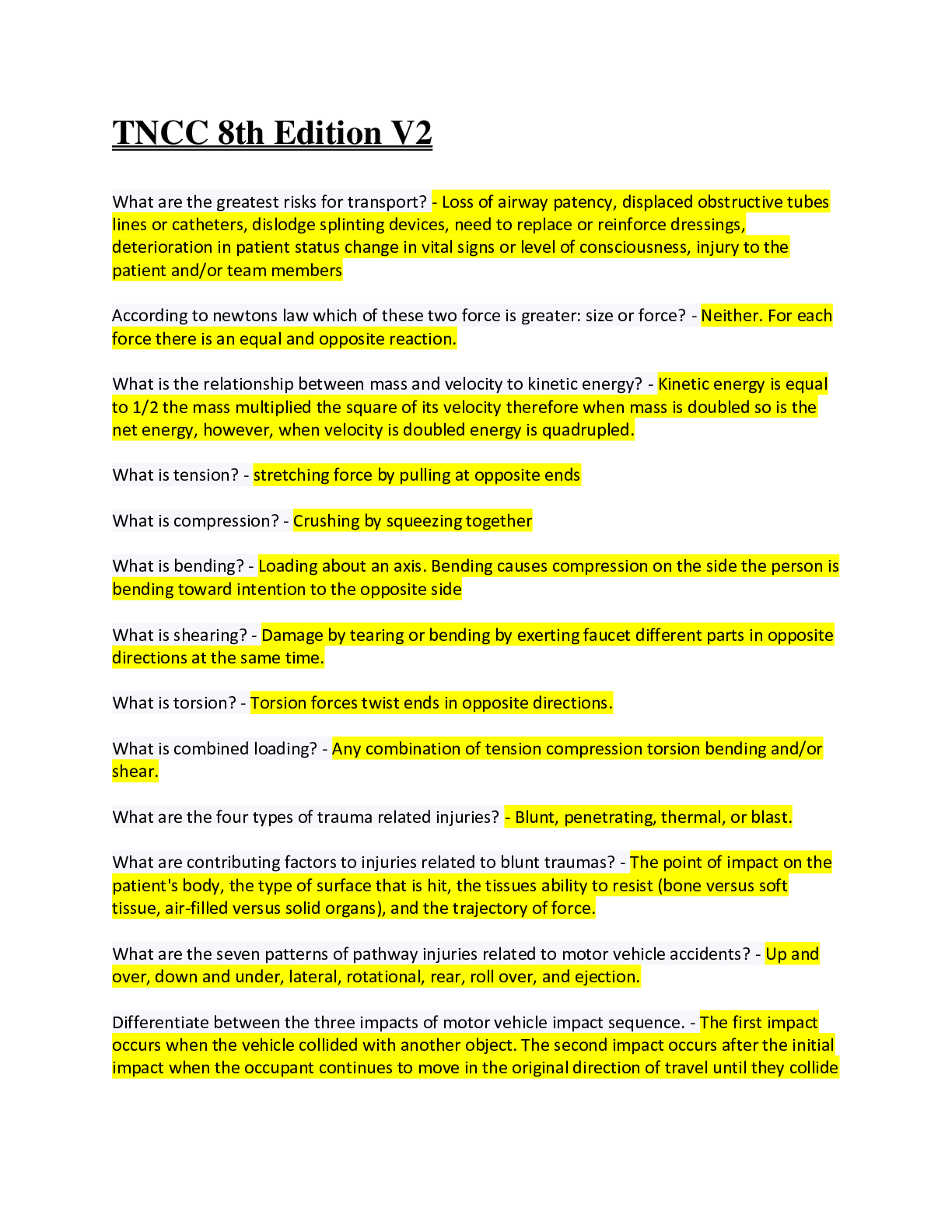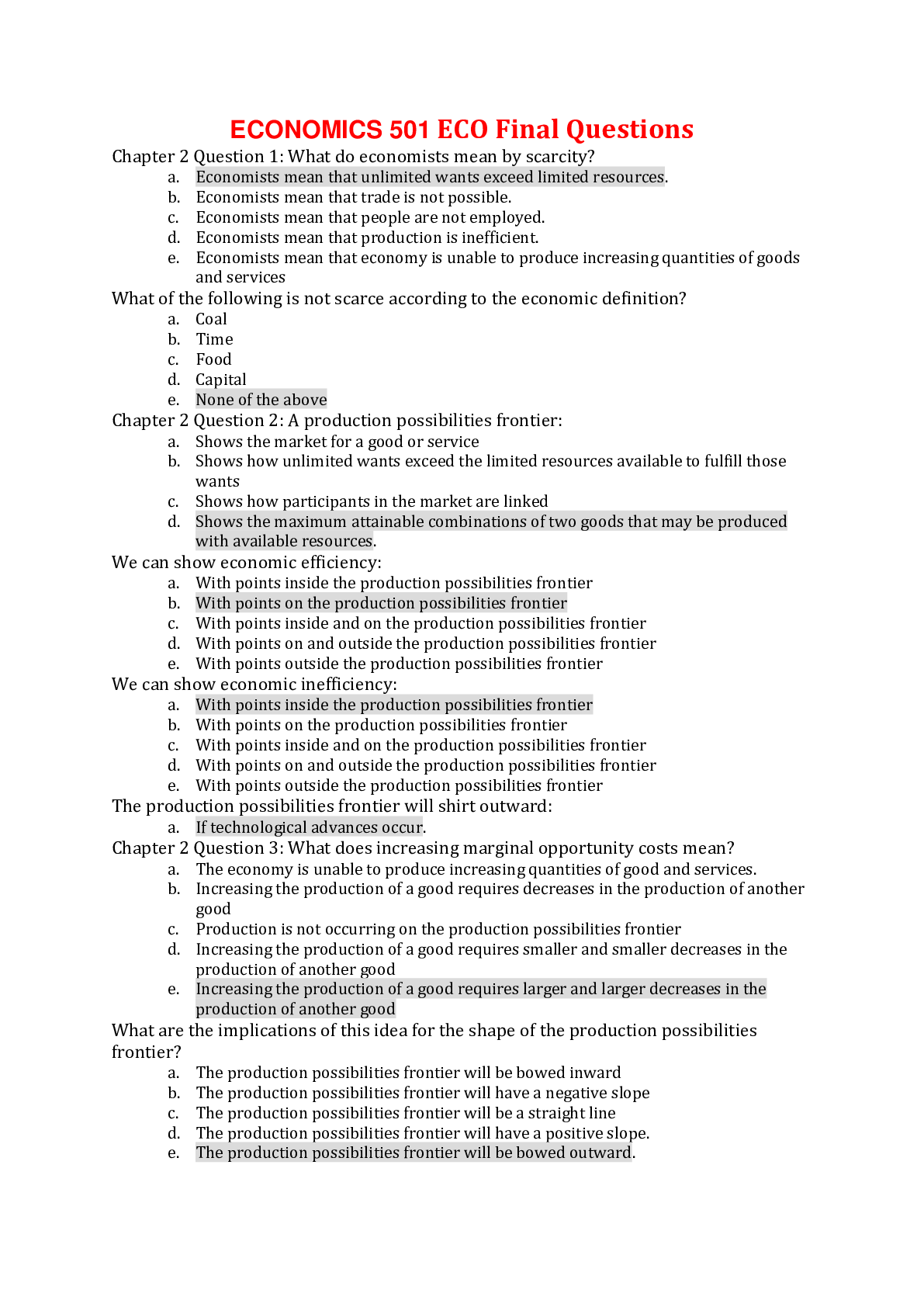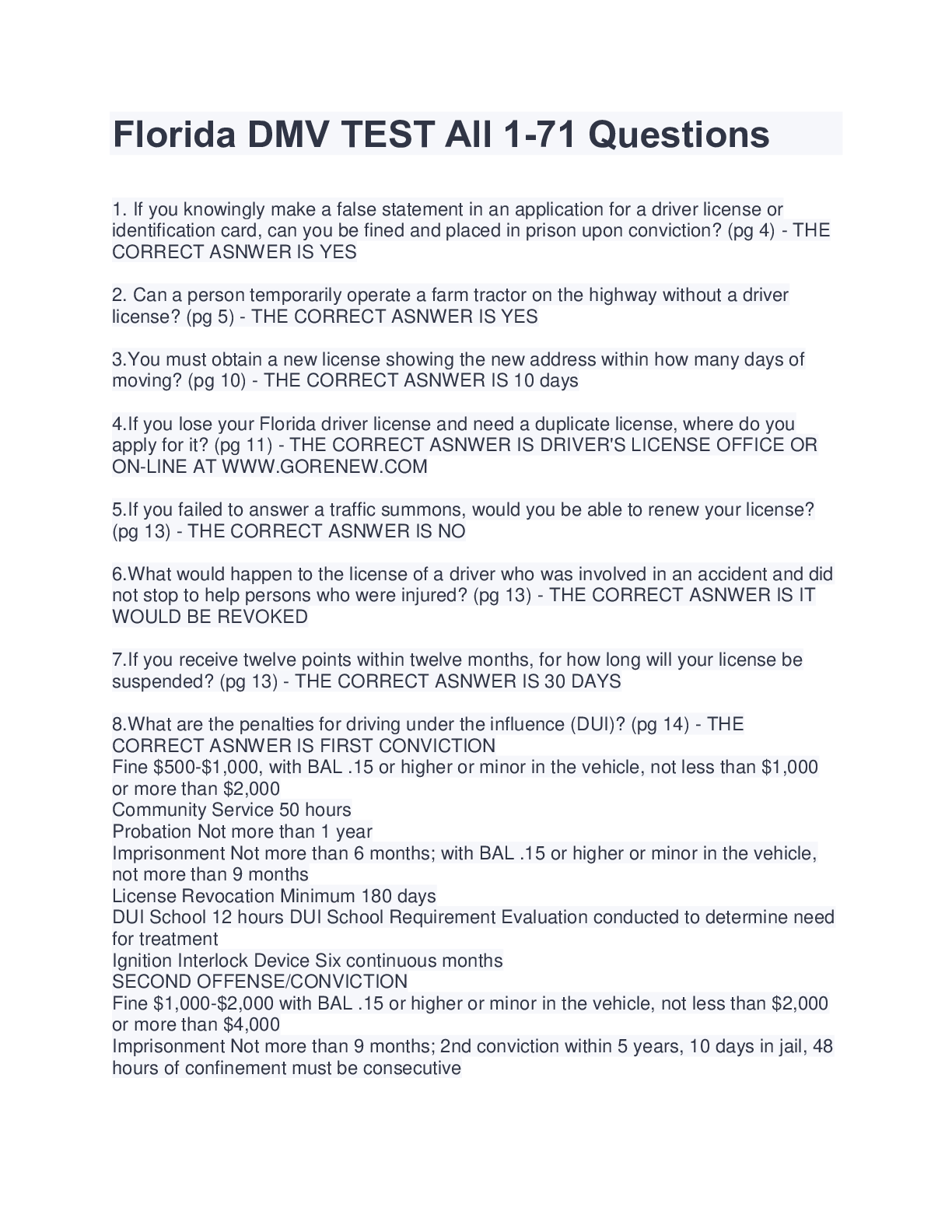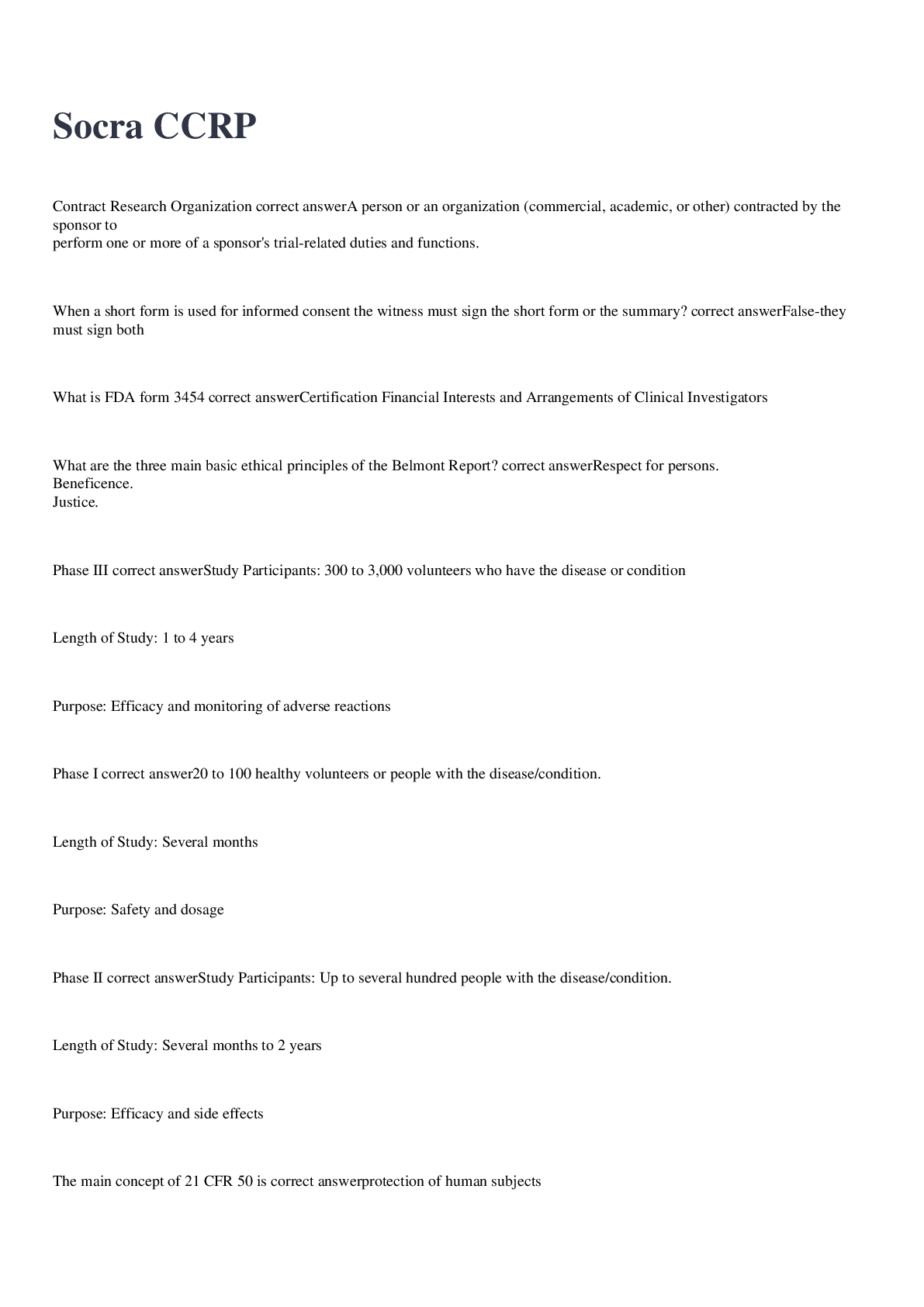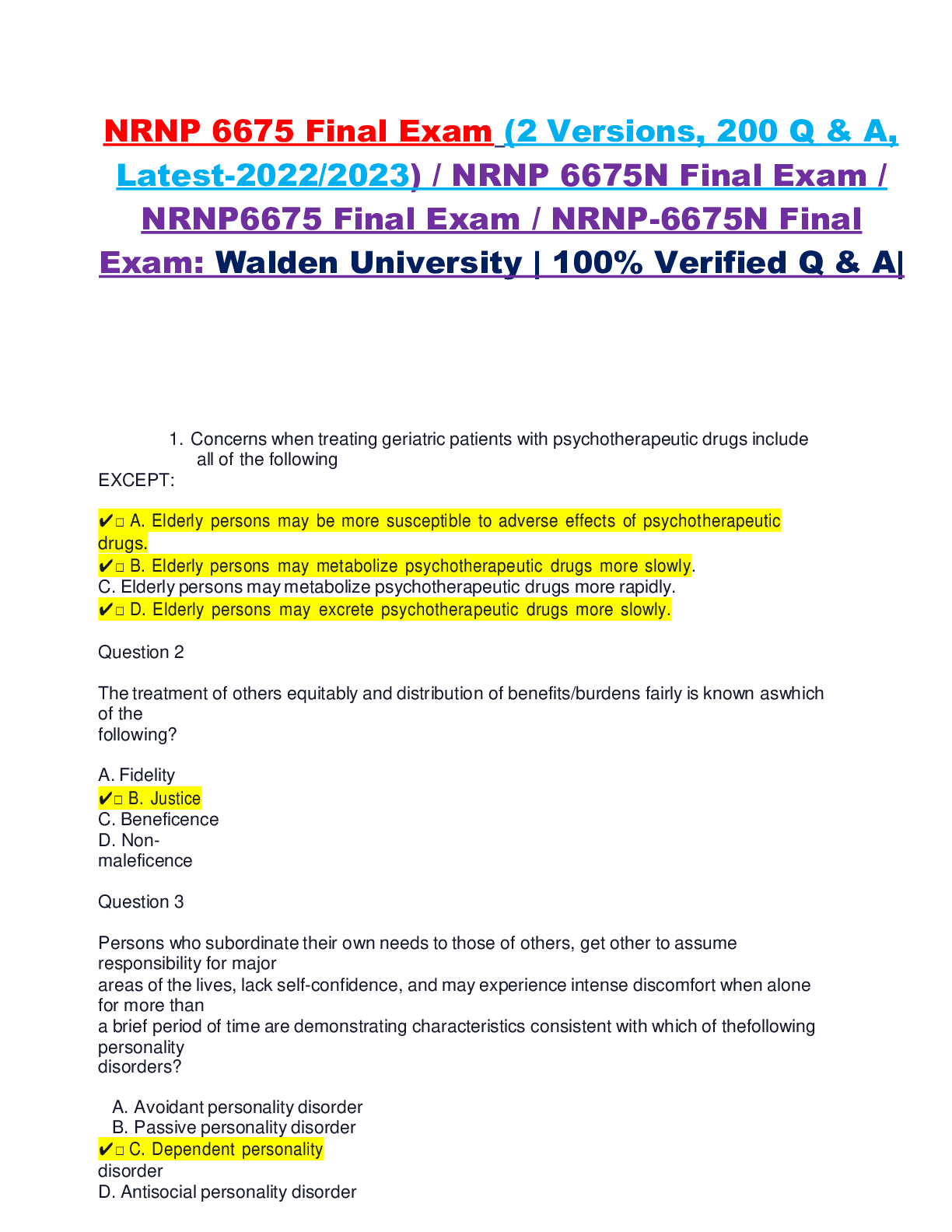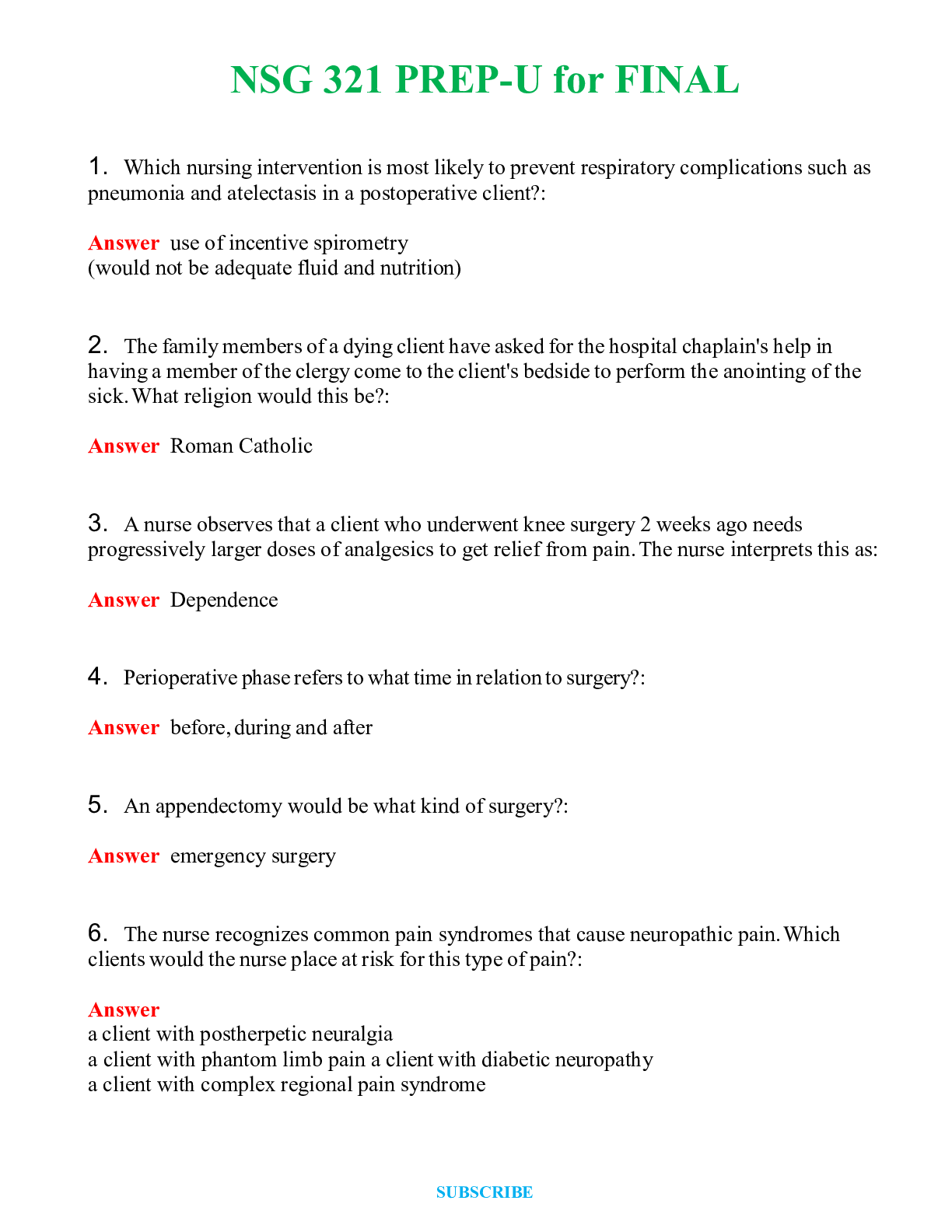HESI RN EXIT EXAM PACK | COMBINED 2019-2022 VERIFIED Q&A
Document Content and Description Below
HESI RN EXIT EXAM-EXAM PACK COMBINED FROM 2019/2020/2021 ACTUAL EXAMS-BEST FOR 2022 EXIT EXAM REVIEW Stuvia.com - The Marketplace to Buy and Sell your Study Material HESI EXIT COMPREHENSI... VE PROCTORED EXAM 1. Which information is most concerning to the nurse when caring for an older client with bilateral cataracts? A. States having difficulty with color perception B. Presents with opacity of the lens upon assessment C. Complains of seeing a cobweb-type structure in the visual field D. Reports the need to use a magnifying glass to see small print Rationale: Visualization of a cobweb- or hairnet-type structure is a sign of a retinal detachment, which constitutes a medical emergency. Clients with cataracts are at increased risk for retinal detachment. Distorted color perception, opacity of the lens, and gradual vision loss are expected signs and symptom of cataracts but do not need immediate attention. 2. When caring for a client hospitalized with Guillain-Barré syndrome, which information is most important for the nurse to report to the primary health care provider? A. Ascending numbness from the feet to the knees B. Decrease in cognitive status of the client C. Blurred vision and sensation changes D. Persistent unilateral headache Rationale: A decline in cognitive status in a client is indicative of symptoms of hypoxia and a possible need to assist the client with mechanical ventilation. A primary health care provider will need to be contacted immediately. Options A, C, and D are findings associated with Guillain-Barré syndrome that should also be reported but are not as critical as the client's hypoxic status. Stuvia.com - The Marketplace to Buy and Sell your Study Material 3. A client is admitted with a diagnosis of leukemia. This condition is manifested by which of the following? A. Fever, elevated white blood count, elevated platelets B. Fatigue, weight loss and anorexia, elevated red blood cells C. Hyperplasia of the gums, elevated white blood count, weakness D. Hypocellular bone marrow aspirate, fever, decreased hemoglobin level Rationale: Hyperplastic gums, weakness, and elevated white blood count are classic signs of leukemia. Options A, B, and D state incorrect information for symptoms of leukemia. 4. The nurse enters the examination room of a client who has been told by her health care provider that she has advanced ovarian cancer. Which response by the nurse is likely to be most supportive for the client? A. "I know many women who have survived ovarian cancer." B. "Let's talk about the treatments of ovarian cancer." C. "In my opinion I would suggest getting a second opinion." D. "Tell me about what you are feeling right now." Rationale: The most therapeutic action for the nurse is to be an active listener and to encourage the client to explore her feelings. Giving false reassurance or personal suggestions are not therapeutic communication for the client. Stuvia.com - The Marketplace to Buy and Sell your Study Material 5. A nurse working in the emergency department admits a client with full-thickness burns to 50% of the body. Assessment findings indicate high-pitched wheezing, heart rate of 120 beats/min, and disorientation. Which action should the nurse take first? A. Insert a large-bore IV for fluid resuscitation. B. Prepare to assist with maintaining the airway. C. Cleanse the wounds using sterile technique. D. Administer an analgesic for pain. Rationale: High-pitched wheezing indicates laryngeal stridor, a sign of laryngeal edema associated with lung injury. Airway management is the first priority of care. Options A, C, and D are all appropriate interventions in managing the client with a burn but are not as critical as establishing an airway. 6. The nurse walks into the room and observes the client experiencing a tonic- clonic seizure. Which intervention should the nurse implement first? A. Restrain the client to protect from injury. B. Flex the neck to ensure stabilization. C. Use a tongue blade to open the airway. D. Turn client on the side to aid ventilation. Rationale: Maintaining the airway during a seizure is the priority for safety. Options A, B, and C are contraindicated during a seizure and may cause further injury to the client. 7. Which intervention should be included in the plan of care for a client admitted to the hospital with ulcerative colitis? A. Administer stool softeners. B. Place the client on fluid restriction. C. Provide a low-residue diet. D. Add a milk product to each meal. Rationale: A low-residue diet will help decrease symptoms of diarrhea, which are clinical manifestations of ulcerative colitis. Options A, B, and D are contraindicated and could worsen the condition. Stuvia.com - The Marketplace to Buy and Sell your Study Material 8. A nurse implements an education program to reduce hospital readmissions for clients with heart failure. Which statement by the client indicates that teaching has been effective? A. "I will not take my digoxin if my heart rate is higher than 100 beats/min." B. "I should weigh myself once a week and report any increases." C. "It is important to increase my fluid intake whenever possible." D. "I should report an increase of swelling in my feet or ankles." Rationale: An increase in edema indicates worsening right-sided heart failure and should be reported to the primary health care provider. Digitalis should be held when the heart rate is lower than 60 beats/min. The client with heart failure should weigh himself or herself daily and report a gain of 2 to 3 lb. An increase in fluid can worsen heart failure. 9. After assessing a 26-year-old client with type 1 diabetes mellitus, which data may indicate that the client is experiencing chronic complications of diabetes? A. Blood pressure, 159/98 mm Hg B. Hemoglobin A1C (HbA1C), 6% C. Creatinine level, 1.0 mg/dL D. Chronic sciatica Rationale: A blood pressure of 159/98 mm Hg is hypertensive and increases the client's risk for acute coronary syndrome and/or stroke. Options B and C are within defined parameters, and Option D is not a recognized chronic complication of diabetes. Stuvia.com - The Marketplace to Buy and Sell your Study Material 10. When caring for a client with a tracheostomy, which intervention should the nurse delegate to the unlicensed assistive personnel (UAP)? A. Teach the family about signs and symptoms of hypoxia. B. Take the vital signs and obtain an O2 saturation level. C. Evaluate the need for tracheal suctioning. D. Revise the plan of care to include tracheostomy care. Rationale: The nurse may delegate obtaining vital signs and O2 saturation; however, the nurse is responsible for following up on any reported data. Options A, C, and D are all part of the nursing process and should not be delegated under the nurse's scope of practice. 11. The charge nurse is making assignments for the upcoming shift. Which client is most appropriate to assign to the practical nurse (PN)? A. A client with nausea who needs a nasogastric tube inserted B. A client in hypertensive crisis who needs titration of IV nitroglycerin C. A newly admitted client who needs to have a plan of care established D. A client who is ready for discharge who needs discharge teaching Rationale: The client mentioned in option A has a need for a skill that is within the scope of practice for the PN. Titration of an IV drip, establishing care plans, and discharge teaching are within the scope of practice of a registered nurse (RN) and are not delegated. Stuvia.com - The Marketplace to Buy and Sell your Study Material 12. A nurse performs an initial admission assessment of a 56-year-old client. Which factor(s) would indicate that the client is at risk for metabolic syndrome? (Select all that apply.) A. Abdominal obesity B. Sedentary lifestyle C. History of hypoglycemia D. Hispanic or Asian ethnicity E. Increased triglycerides Rationale: Metabolic syndrome is a name for a group of risk factors that increase the risk for coronary artery disease, type 2 diabetes, and stroke (A, B, D, and E). Hypoglycemia is not a risk factor for metabolic syndrome (C). 13. Which clinical manifestation in the client with hyperthyroidism is most important to report to the health care provider? A. Nervousness B. Increased appetite C. Apical heart rate of 130 beats/min D. Insomnia Rationale: The apical heart rate of 130 beats/min is a critical finding that could lead to heart failure or other cardiac disorders. Options A, B, and D are all expected findings that should also be reported but are not as critical. 14. The nurse administers atropine sulfate ophthalmic drops preoperatively to the right eye of a client scheduled for cataract surgery. Which response by the client indicates that the drug was effective? A. The pupils become equal and reactive to light. B. The right pupil constricts within 30 minutes. C. Bilateral visual accommodation is restored. D. The right pupil dilates after drop instillation. Rationale: Atropine is a mydriatic drug which causes pupil dilation and paralysis in Stuvia.com - The Marketplace to Buy and Sell your Study Material preparation for surgery or examination. Options A, B, and C do not describe the therapeutic effects of atropine sulfate ophthalmic drops prior to cataract surgery. 15. A client with human immunodeficiency virus (HIV) develops a painful blistering skin rash on the right lateral abdominal area. Which drug should the nurse expect to administer to treat this condition? A. Levofloxacin B. Acyclovir sodium C. Fluconazole D. Esomeprazole Rationale: The clinical manifestations listed are consistent with herpes zoster (shingles). Acyclovir sodium is an antiviral used to treat herpes zoster or shingles. Levofloxacin is an antibiotic and may be used to treat pneumonia or other infections in the HIV client. Fluconazole is an antifungal and is used to treat candidiasis in the HIV client. Esomeprazole is a protein pump inhibitor used for gastroesophageal reflux disease. 16. When assessing a 38-year-old client with tuberculosis who is taking rifampin, which finding would be most important to report to the primary health care provider immediately? A. Orange-colored urine B. Potassium level, 4.9 mEq/L C. Elevated liver enzyme levels D. Blood urea nitrogen (BUN) level, 12 mg/dL. Rationale: Rifampin can cause hepatotoxicity, so elevated liver enzyme levels need to be closely monitored and reported to the health care provider. Orange discoloration of the urine is an expected side effect of this medication. The potassium level is normal. A BUN level of 12 mg/dL is within defined parameters. Stuvia.com - The Marketplace to Buy and Sell your Study Material 17. A client with non-Hodgkin lymphoma has been prescribed cyclophosphamide IV for therapy. Which assessment finding would need to be reported immediately to the oncologist? A. Sores on the mouth or tongue B. Chills, fever, and sore throat C. Loss of appetite or weight with diarrhea D. Changes in color of fingernails or toenails Rationale: Cyclophosphamide is an immunosuppressive drug used to treat lymphoma and puts the client at risk for infection. Signs and symptoms of an infection should be reported to the oncologist immediately. Options A and C are expected signs and symptoms of non-Hodgkin lymphoma. Option D is a normal side effect of cyclophosphamide. 18. A nurse is assessing a client with heart failure who has been prescribed digoxin for therapy. Which finding indicates an issue with the medication management? A. Regular heart rate of 88 beats/min B. Serum potassium level, 2.9 mEq/L C. Weight decreases by 1 lb daily D. Serum sodium level, 138 mEq/L Rationale: A serum potassium level of 2.9 mEq/L is low, and side effects of digoxin toxicity are exacerbated when the potassium level is low. Options A, C, and D are all expected findings when caring for a client with congestive heart failure. 19. Which statement by the U.S. Food and Drug Administration (FDA) is an example of a black box or black label warning for the drug clopidogrel? A. This drug could cause heart attack or stroke when taken by clients with certain genetic conditions. B. Clopidogrel helps prevent platelets from sticking together and forming clots in the blood. C. This drug can be taken in combination with aspirin to reduce the risk of acute coronary syndrome. D. Clopidogrel can reduce the risk of a future heart Stuvia.com - The Marketplace to Buy and Sell your Study Material attack when taken by clients with peripheral artery disease. Rationale: A black box warning is a notice required by the FDA on a prescription drug that warns of potentially dangerous side effects. Options B, C, and D are all desired effects of the drug. 20. The nurse is caring for a client with an ischemic stroke who has a prescription for tissue plasminogen activator (t-PA) IV. Which actions should the nurse expect to implement? (Select all that apply.) A. Administer aspirin with tissue plasminogen activator (t-PA). B. Complete the National Institute of Health Stroke Scale (NIHSS). C. Assess the client for signs of bleeding during and after the infusion. D. Start t-PA within 6 hours after the onset of stroke symptoms. E. Initiate multidisciplinary consult for potential rehabilitation. Rationale: Neurologic assessment, including the NIHSS, is indicated for the client receiving t- PA. This includes close monitoring for bleeding during and after the infusion; if bleeding or other signs of neurologic impairment occur, the infusion should be stopped (B, C, and E). Aspirin is contrain-dicated with t-PA because it increases the risk for bleeding (A). The administration of t-PA within 6 hours of symptoms is concurrent with a diagnosis of a myocardial infarction and within 4.5 hours of symptoms is concurrent for a stroke (D). 21. Which action by the nurse is consistent with culturally competent care? A. Treating each client the same regardless of race or religion B. Ensuring that all Native American clients have access to a shaman C. Understanding one's own world view in addition to the client's Stuvia.com - The Marketplace to Buy and Sell your Study Material D. Including the family in the plan of care for older clients Rationale: The nurse should understand his or her own values and views to prevent those values from being imparted to others, in addition to understanding the client's cultural views. Treating every client the same or assuming that all clients share the same values does not exhibit cultural competence or sensitivity. 22. The charge nurse reviews the charting of a graduate nurse. Which indicates a need for further education on documentation? A. Uses descriptive words such as "gurgling" to describe breath sounds. B. Records temperature 30 minutes before and after giving acetaminophen. C. Charts some actions in advance of performing them. D. Includes the client's response to an intervention. Rationale: Charting actions prior to implementing them is an example of fraudulent charting, and the graduate nurse should receive further education. Options A, B, and D are appropriate charting examples. 23. Which data obtained during a respiratory assessment for a 78-year-old client is most important to report to the primary health care provider? A. Auscultation of vesicular breath sounds B. Pulse oximetry reading of 89% C. Arterial PaO2 of 86% D. Resonance on percussion of the lungs Rationale: An oxygen saturation lower than 90% indicates hypoxia. Options A, C, and D are all normal findings. 24. The nurse hears a series of long-duration, discontinuous, low-pitched sounds on auscultation of a client's lower lung fields. Which documentation of this finding is correct? Stuvia.com - The Marketplace to Buy and Sell your Study Material A. Fine crackles B. Wheezes C. Course crackles D. Stridor Rationale: Course crackles are caused by air passing through airways that are intermittently occluded by mucus. Fine crackles are a series of short-duration, discontinuous, high-pitched sounds. Wheezes are continuous, high-pitched, musical or squeaking- type sounds. Stridor is a continuous croupy sound of constant pitch and indicates partial obstruction of the airway. 25. The nurse empties a client's urinary drainage from an indwelling Foley catheter. Which finding should be reported to the primary health care provider? A. Ammonia odor is noted when the catheter is emptied. B. 240 mL of urinary output is produced in 12 hours. C. A 16-French catheter was used for an adult female. D. Drainage system is hanging below the level of the bladder. Rationale: An expected finding is between 400 and 750 mL in 12 hours = average of 30 mL/hr. Ammonia odor is an expected finding. Size 14- to 18-French catheters are common sizes used in the adult female. Below the level of the bladder is the correct position for the drainage bag. 26. When blood or blood products are administered, which task can be assigned to the licensed practical nurse (PN)? A. Initiation of the blood product B. Obtaining vital signs after infusion has begun C. Assessment of client's condition prior to blood administration D. Evaluation of client's response after receiving blood product Rationale: Blood and blood products must be initiated by the registered nurse (RN); however, Stuvia.com - The Marketplace to Buy and Sell your Study Material obtaining vital signs may be delegated as long as the results are evaluated by the RN. Options A, C, and D are all part of the nursing process and the scope of the RN. 27. The charge nurse observes a student nurse enter the room of a client who is prescribed airborne precautions. The application of which personal protective equipment by the student indicates a correct understanding of this precaution? A. Surgical mask, clean gloves, and gown B. Properly fitted N95 respirator or mask C. Sterile gloves and gown D. Goggles, clean gloves, and gown Rationale: The use of personal protective equipment (PPE) for airborne precautions includes a properly prefitted N95 respirator or mask. Options A, C, and D do not provide the appropriate respiratory equipment for airborne precautions. A surgical mask is used for preventing transmission of droplet precautions. 28. The nurse reviews the comprehensive metabolic panel for a client with an electrolyte imbalance. Which data requires the most immediate intervention by the nurse? A. Potassium level, 3.9 mEq/dL B. Creatinine level, 1.1 mg/dL C. Sodium level, 125 mEq/L D. Calcium level, 9 mg/dL Rationale: The normal serum sodium level is 135 to 145 mEq/L. This value indicates hyponatremia. Symptoms of hyponatremia include nausea and vomiting, headache, confusion, and seizures, which can be severe and need immediate attention. Options A, B, and D are all within normal parameters. 29. A client is admitted to the hospital with the diagnosis of hypokalemia. Which clinical manifestation is most significant? A. Heart palpitations B. Leg cramps Stuvia.com - The Marketplace to Buy and Sell your Study Material C. Nausea D. Tetany Rationale: Hypokalemia can cause heart palpitations, which are indicative of a dysrhythmia that could progress to a medical emergency. Options B and C are also of concern but are not as life threatening. Option D is a symptom of hypocalcemia. 30. The nurse prepares to administer 3 units of regular insulin and 20 units of NPH insulin subcutaneously to a client with an elevated blood glucose level. Which procedure is correct? A. Using one syringe, first insert air into the regular vial and then insert air into the NPH vial. B. Using one syringe, add the regular insulin into the syringe and then add the NPH insulin. C. Avoid combining the two insulins because incompatibility could cause an adverse reaction. D. Administer the regular insulin subcutaneously and then give the NPH IV to prevent a separate stick. Rationale: The regular or "clear" insulin should be withdrawn into the syringe first, followed by the NPH. Air should first be injected into the NPH vial and then air should be inserted into the regular vial. NPH and regular insulin are compatible, and combining will reduce the number of injections. The insulin is ordered subcutaneously and NPH cannot be given IV. 31. The nurse is caring for a client on the medical unit. Which task can be delegated to unlicensed assistive personnel (UAP)? A. Assess the need to change a central line dressing. B. Obtain a fingerstick blood glucose level. Stuvia.com - The Marketplace to Buy and Sell your Study Material C. Answer a family member's questions about the client's plan of care. D. Teach the client side effects to report related to the current medication regimen. Rationale: Obtaining a fingerstick blood glucose level is a simple treatment and is an appropriate skill for UAP to perform. Options A, C, and D are skills that cannot be delegated to UAP. 32. Which disaster management intervention by the nurse is an example of primary prevention? A. Emergency department triage B. Follow-up care for psychological problems C. Education of rescue workers in first aid D. Treatment of clients who are injured Rationale: Primary prevention is aimed at preventing disease or injury. Training rescue workers prior to a disaster is an example of minimizing or preventing injury. Option A is an example of secondary prevention. Option B is an example of tertiary prevention. Option D is an example of secondary prevention. 33. The nurse teaches a class on bioterrorism. Which methods of transmission are possible with the biologic agent Bacillus anthracis(Anthrax)? (Select all that apply.) A. Inhalation of powder form B. Handling of infected animals C. Spread from person to person through coughing D. Eating undercooked meat from infected animals E. Direct cutaneous contact with the powder Rationale: Anthrax can be transmitted by the inhalation, cutaneous, and digestive routes (A, B, D, and E); however, the disease is not spread from person to person (C). 34. The nurse assesses a pressure ulcer on a client's heel and notes full-thickness tissue loss, with some visible subcutaneous fat. How should the nurse stage this pressure ulcer? Stuvia.com - The Marketplace to Buy and Sell your Study Material A. Stage I B. Stage II C. Stage III D. Stage IV Rationale: The statement above describes a stage III ulcer, which is defined as full-thickness tissue loss in which subcutaneous fat may be exposed but without exposure of bone, tendon, or muscle. A stage I ulcer includes intact skin with nonblanchable redness of a localized area. A stage II ulcer is described by partial-thickness loss of dermis, including a shallow open ulcer with a pinkish red wound bed. Full- thickness tissue loss with exposed bone, tendon, or muscle and slough or eschar is indicative of a stage IV ulcer. 35. The nurse prepares to administer ophthalmic drops to a client prior to cataract surgery. List the steps in the order that they should be implemented from first step to final step. 1. Drop prescribed number of drops into conjunctival sac. 2. Wash hands and apply clean gloves. 3. Place dominant hand on the client’s forehead. 4. Ask the client to close the eye gently. A. 3, 2, 1, 4 B. 2, 3, 1, 4 C. 3, 2, 4, 1 D. 2, 3, 4, 1 Rationale: Washing hands and applying gloves prior to procedure initiation prevents the spread of infection (2). Placing the dominant hand on the client’s forehead (3) stabilizes the hand so the nurse can hold the dropper 1 to 2 cm above the conjunctival sac and drop the prescribed number of drops (1); asking the client to close the eye gently helps distribute the medication (4). 36. The nurse is caring for a client who is experiencing severe pain. The expected outcome the nurse writes for the client reads, "The client will state my pain is <2 within 45 minutes after pain medication has been administered." Formulating the expected outcome is an example of which step in the nursing process? Stuvia.com - The Marketplace to Buy and Sell your Study Material A. Assessment B. Planning C. Implementation D. Evaluation Rationale: Planning allows the nurse to set goals for care and elicit the expected outcome by identifying appropriate nursing actions. Assessment, implementation, and evaluation are part of the care for the client but are not the appropriate actions for formulating the expected outcome. 37. When assessing safety for the older adult, which of the following is of highest priority to the nurse? A. The client has a cataract in the right eye. B. The client is not married and lives alone. C. The client lives in a two-story building. D. The client reports a history of repeated falls. Rationale: Risk assessment for falls is a critical element in caring for the older adult. Options A, B, and C are important components in assessing client risk, but a history of prior falls puts the older client at very high risk for falling again. [Show More]
Last updated: 1 year ago
Preview 1 out of pages

Reviews( 0 )
Document information
Connected school, study & course
About the document
Uploaded On
Aug 01, 2022
Number of pages
Written in
Additional information
This document has been written for:
Uploaded
Aug 01, 2022
Downloads
0
Views
3

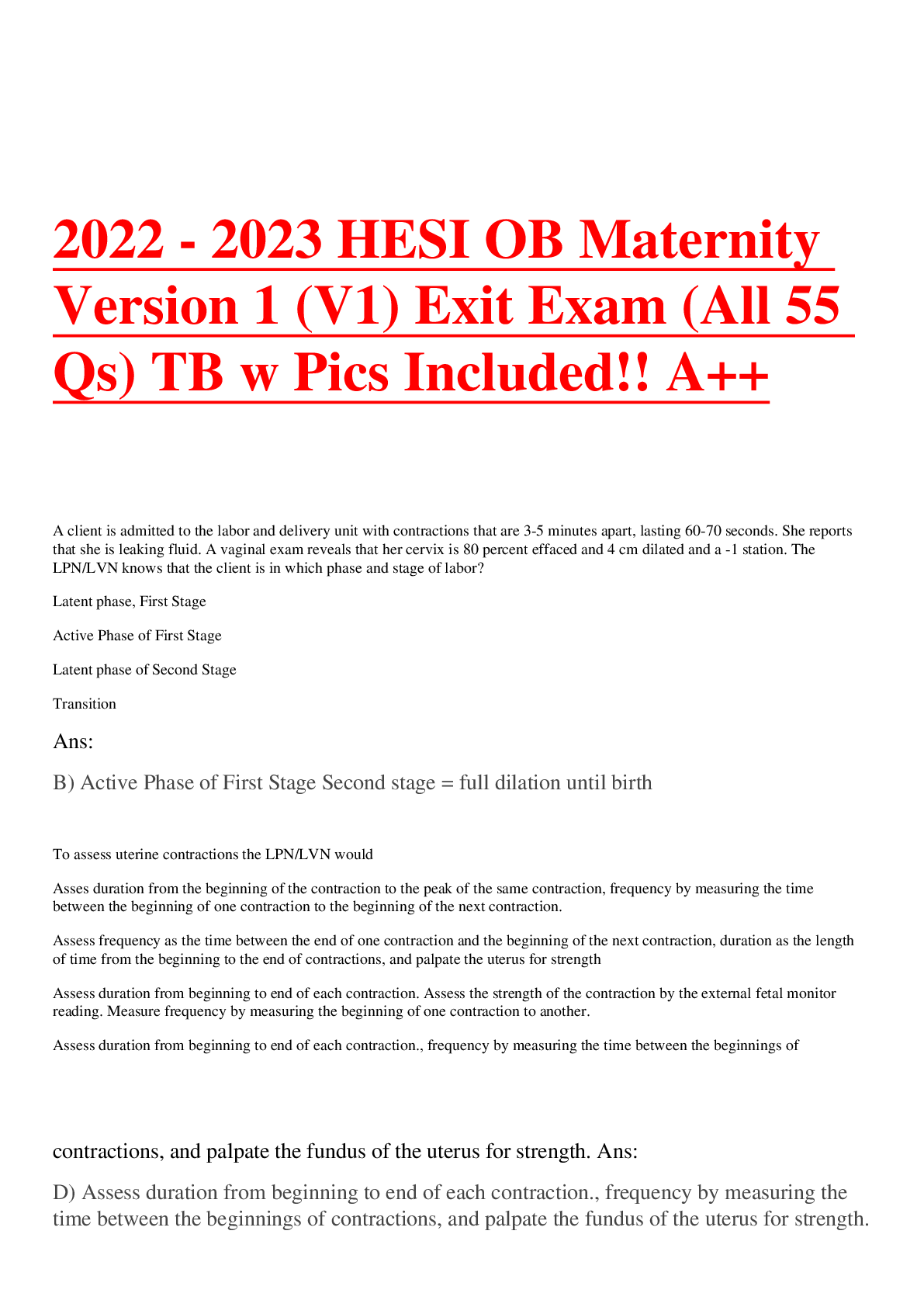
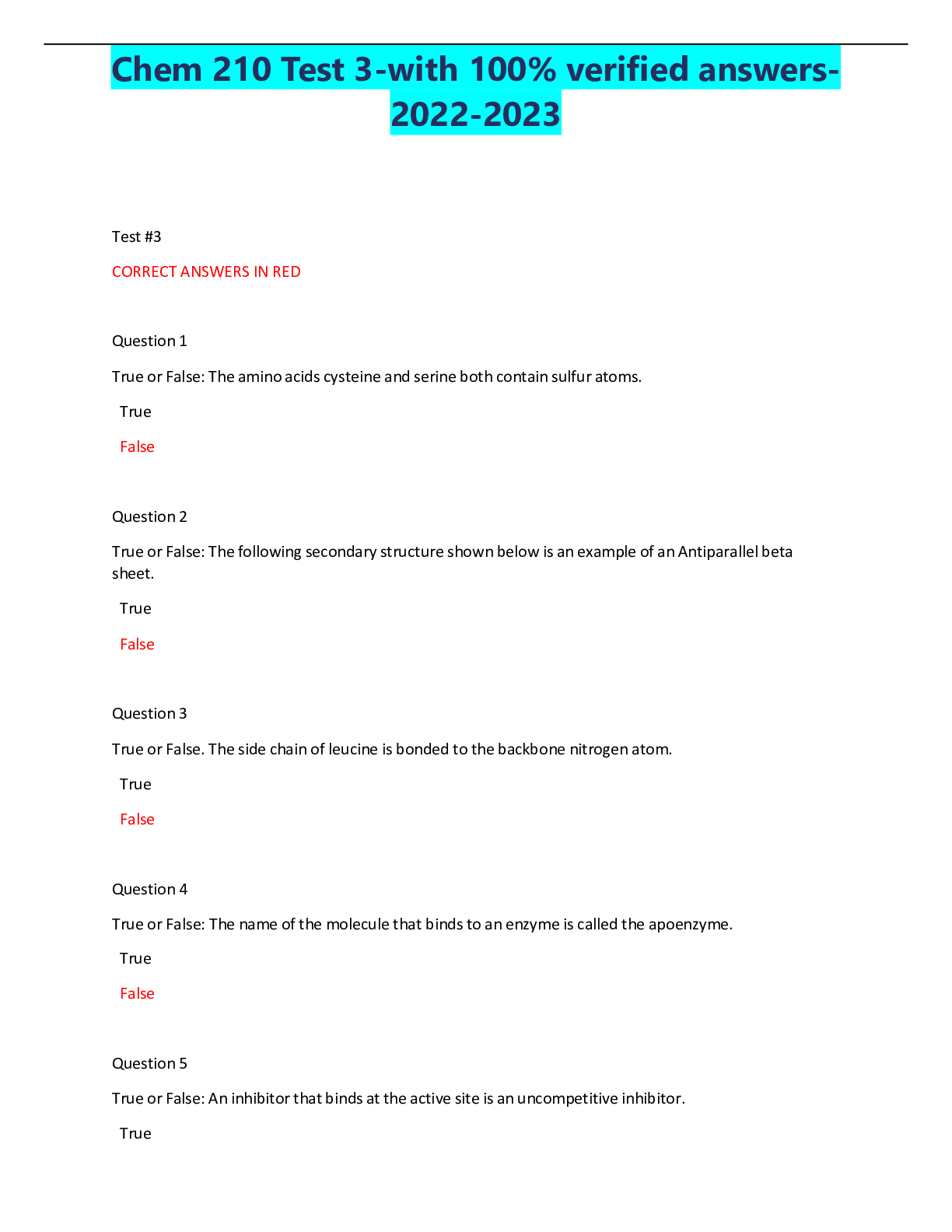
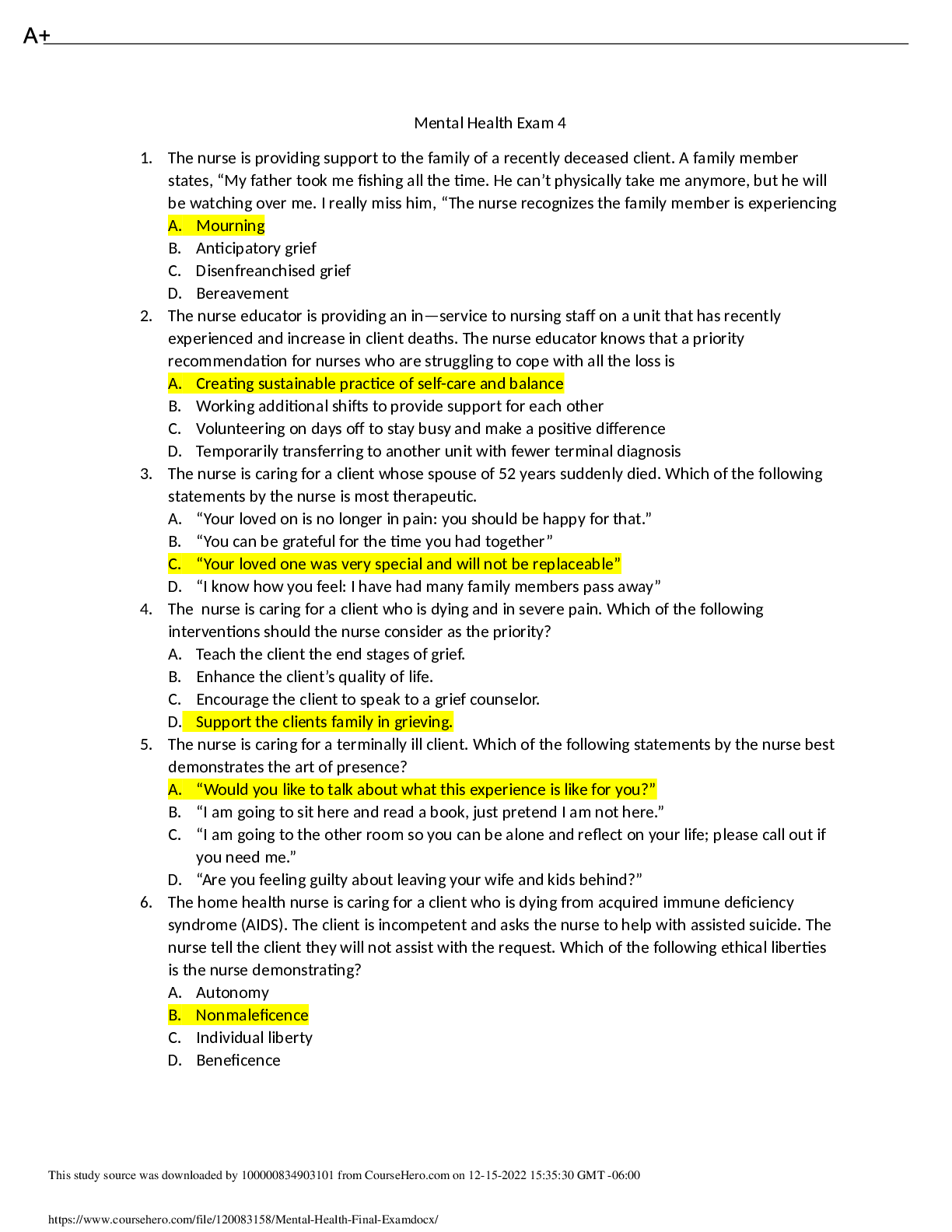
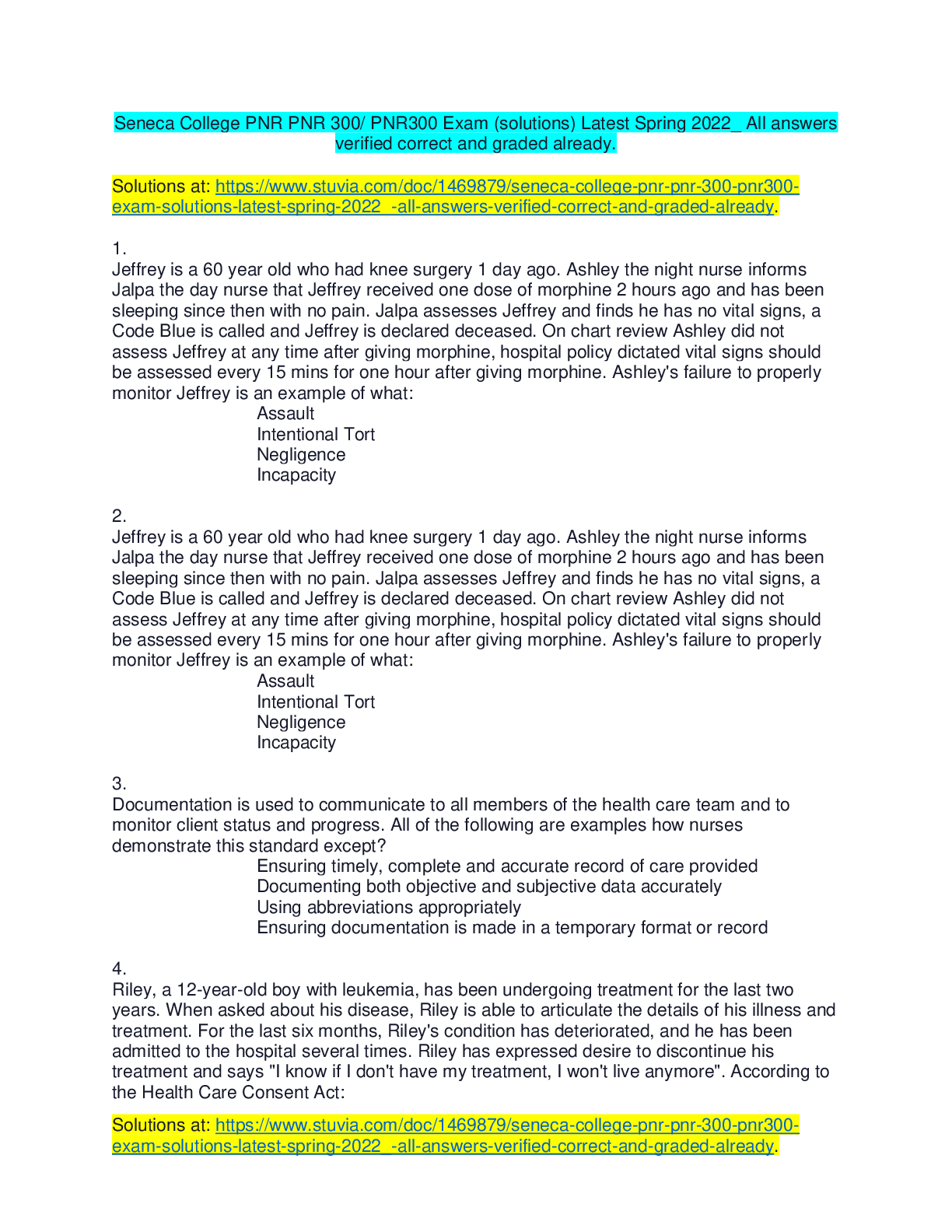
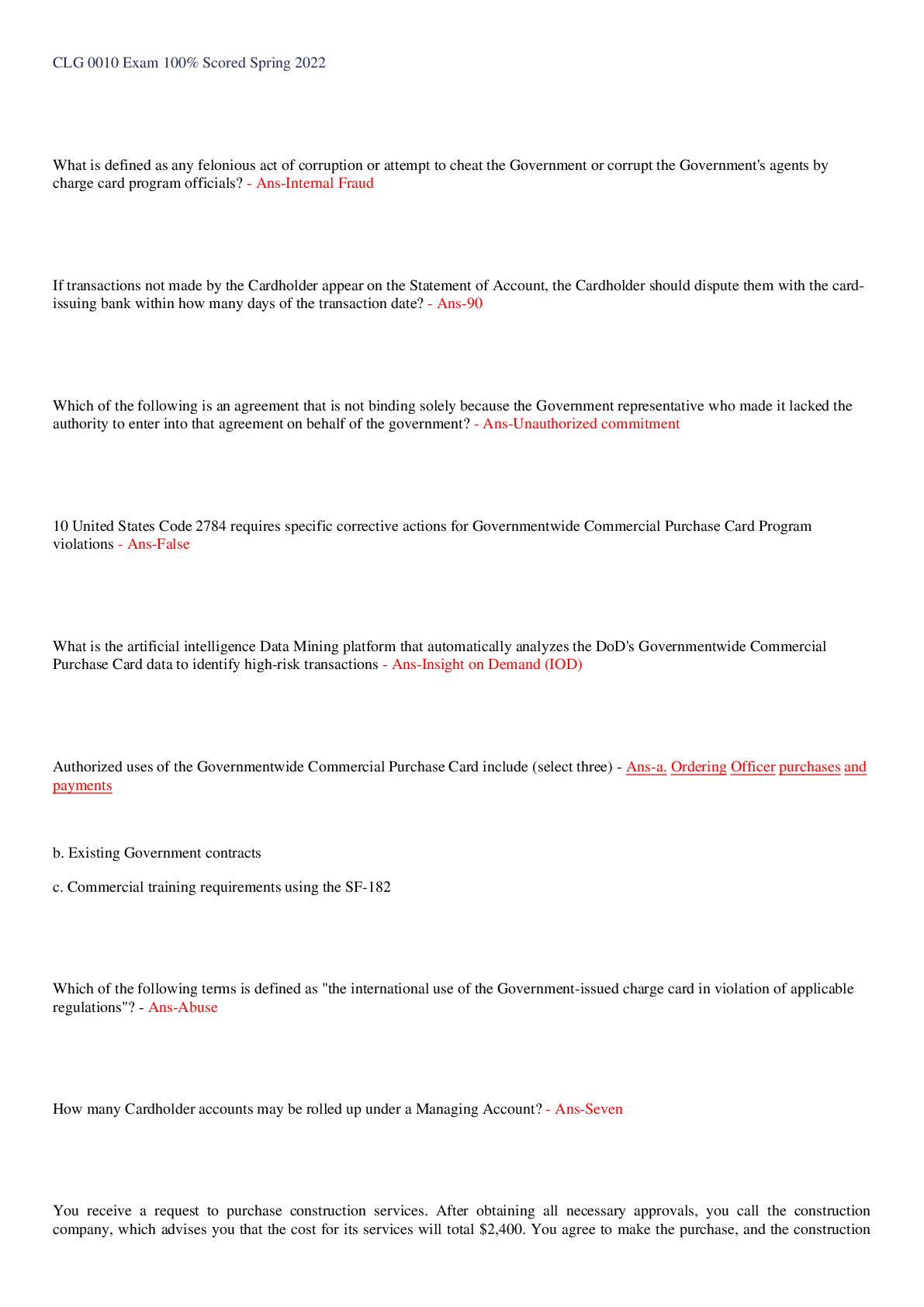

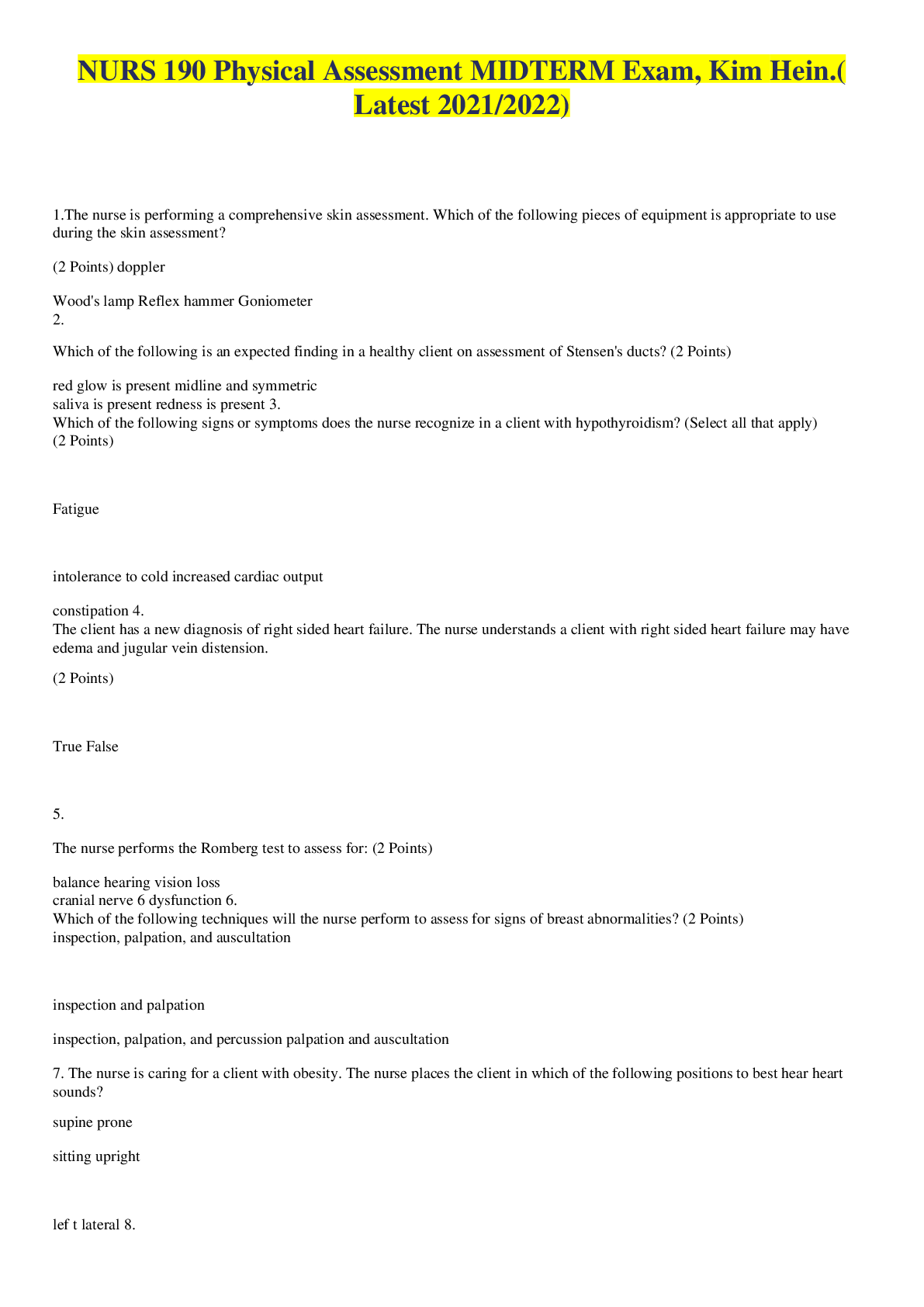
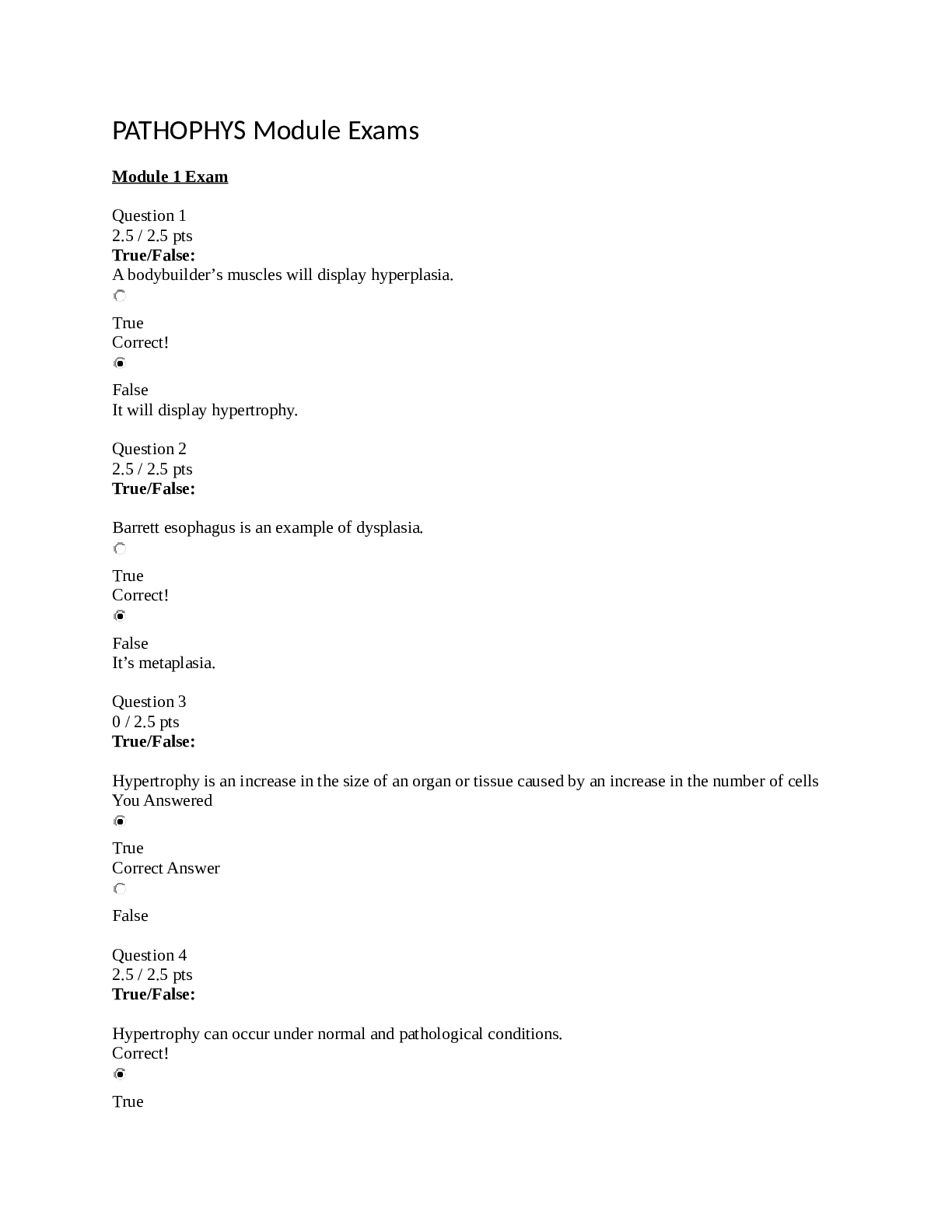
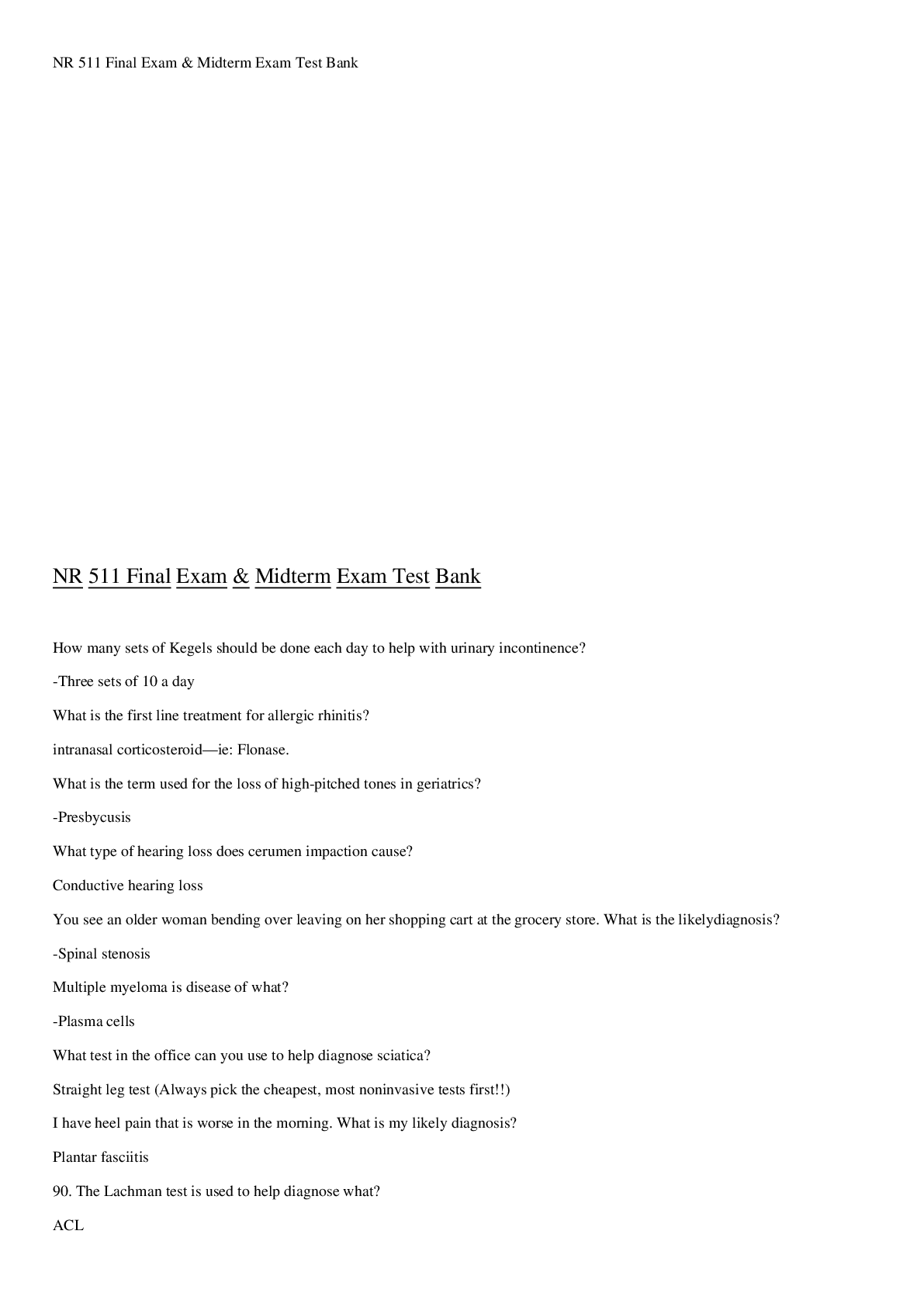
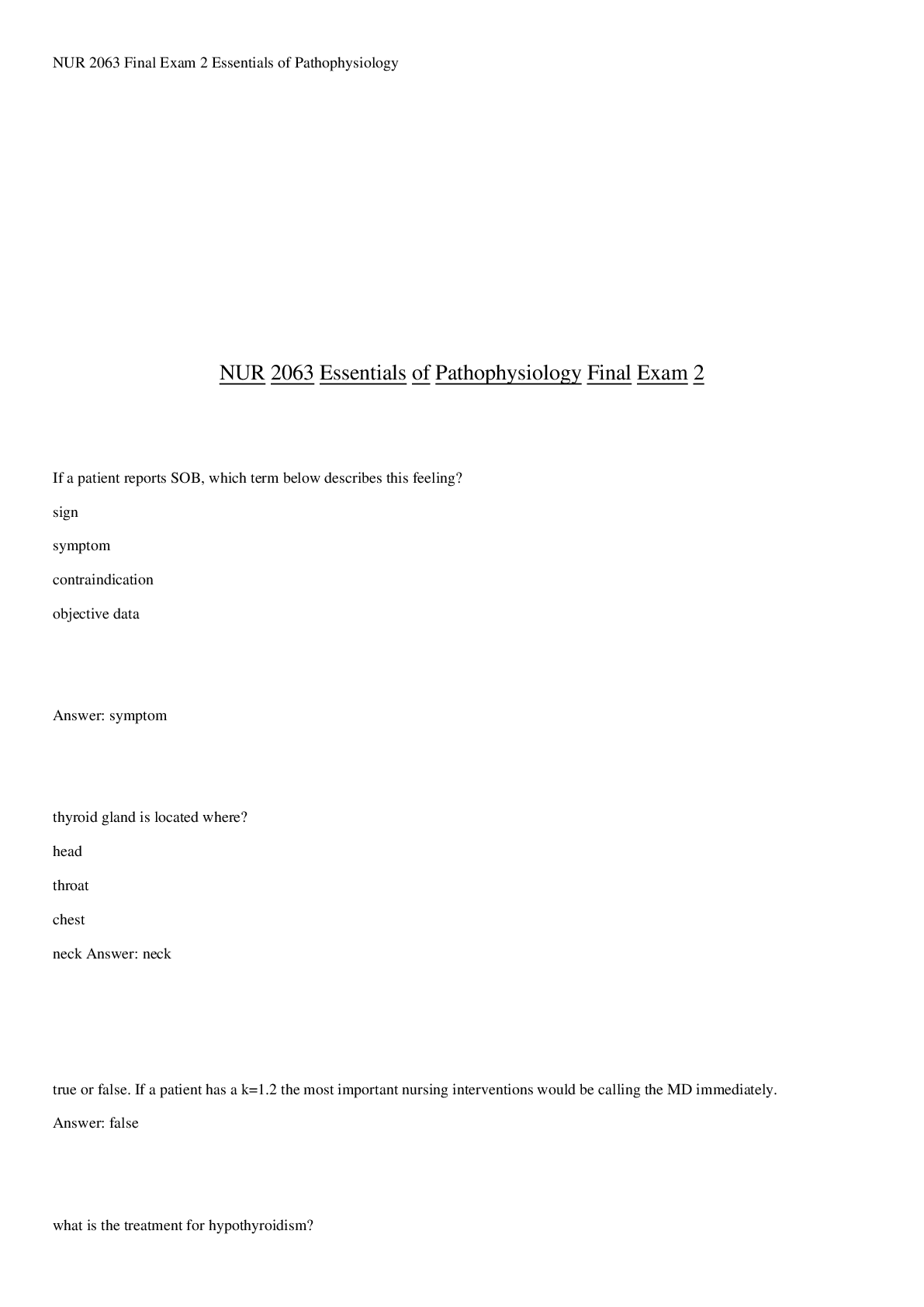
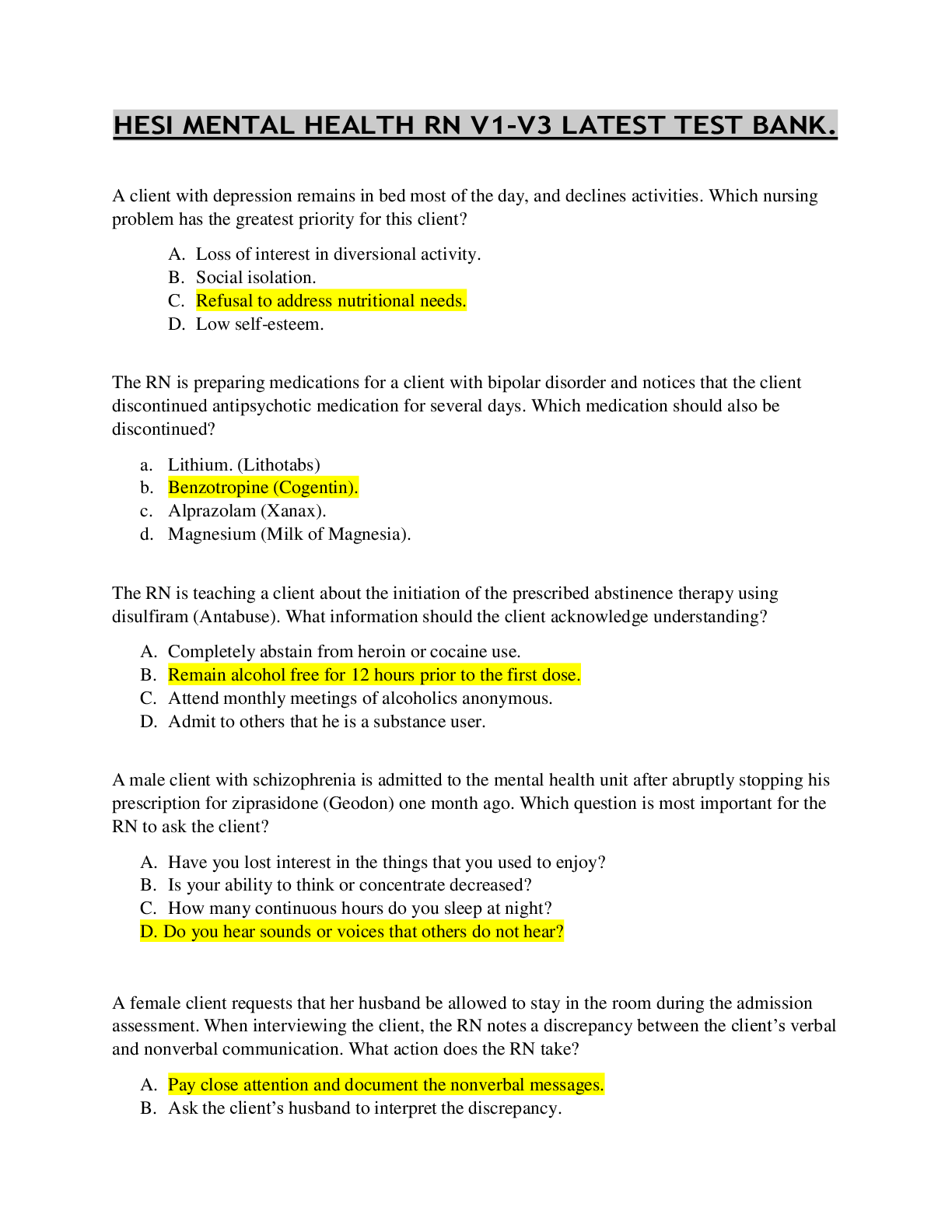
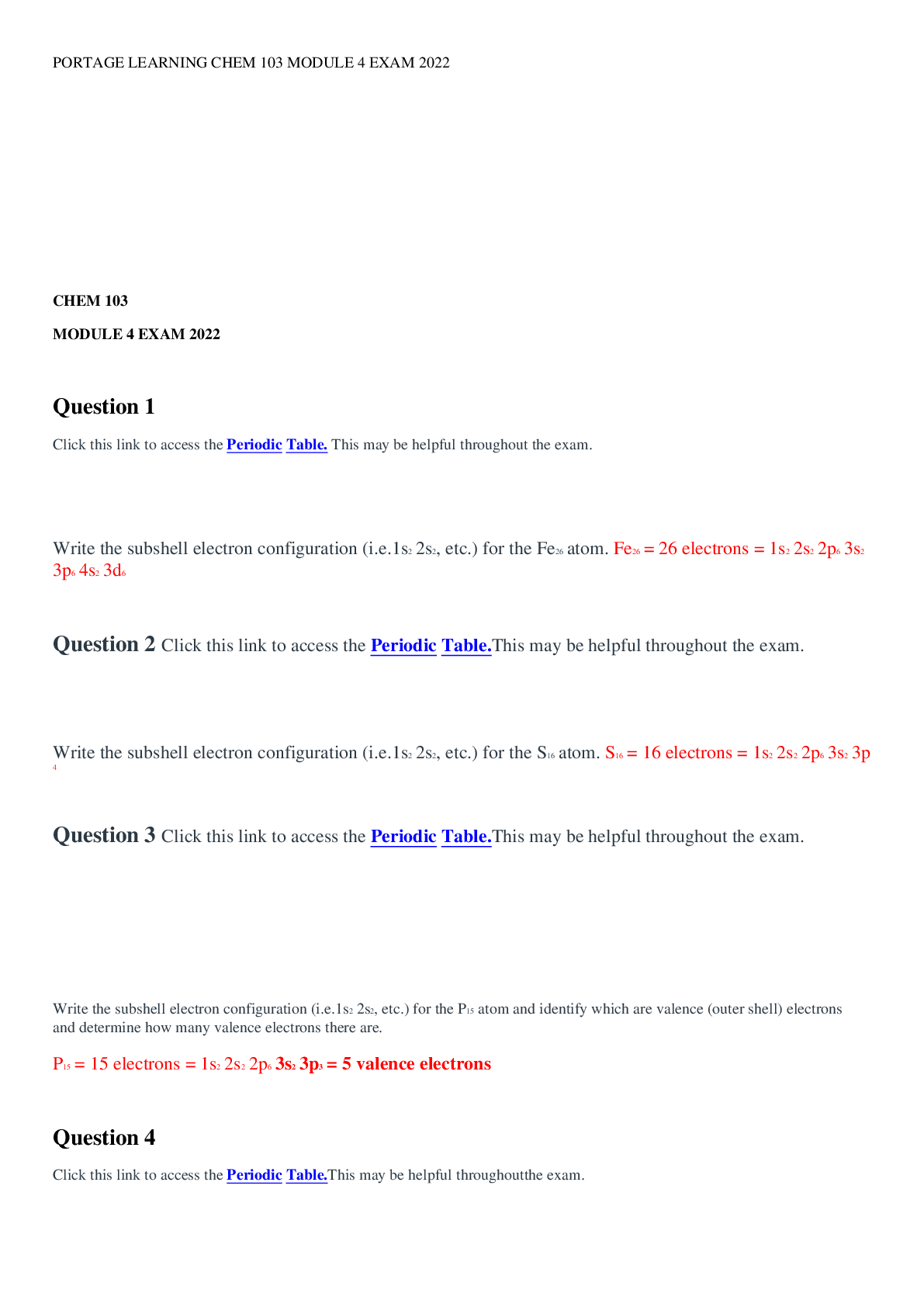
.png)




